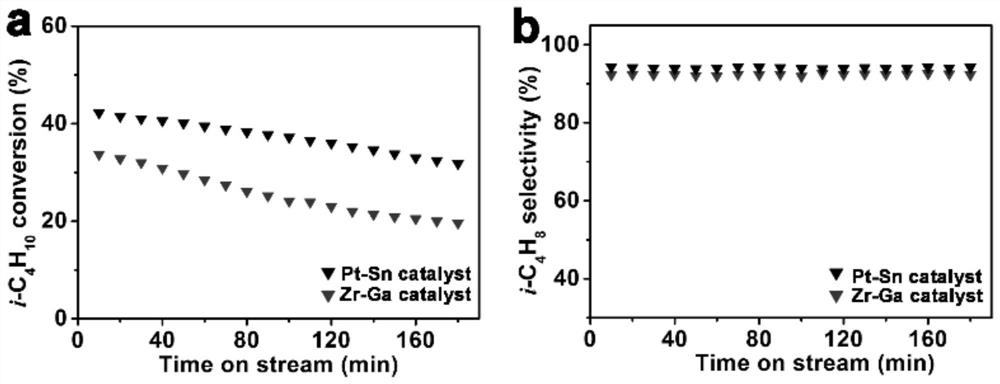A kind of light alkane dehydrogenation catalyst and method for preparing light alkene
A dehydrogenation catalyst and a technology for low-carbon alkanes, which are applied in the field of low-carbon alkane dehydrogenation catalysts and the preparation of low-carbon olefins, and can solve the problems of not providing stability data in the carbon burning regeneration process, and decreasing activity.
- Summary
- Abstract
- Description
- Claims
- Application Information
AI Technical Summary
Problems solved by technology
Method used
Image
Examples
Embodiment 1
[0033] Put the silicon-alumina molecular sieve carrier with a silicon-aluminum mass ratio of 10 into a drying oven at 100° C. to dry overnight, and weigh 96 g of the carrier for use.
[0034] a) Prepare mixed solution: weigh 1g of zirconium nitrate and 3g of gallium nitrate and dissolve in water to prepare mixed solution;
[0035] b) Impregnation: adding the above-mentioned prepared mixed solution dropwise into the reactor equipped with the dried silica-alumina molecular sieve carrier, and keeping gentle stirring;
[0036] c) Stand still: put the above-mentioned impregnated slurry into an oven, and let it stand overnight at 100° C., so that the zirconium-gallium ions can be fully impregnated on the surface and pores of the carrier;
[0037] d) High-temperature calcination: put the crude product after standing still in a muffle furnace for high-temperature calcination at 750° C. for 2 hours, and the calcination atmosphere is air.
[0038] Obtain the catalyst sample of correspo...
Embodiment 2
[0040] Put the silicon-alumina molecular sieve carrier with a silicon-aluminum mass ratio of 10 into a drying oven at 100° C. to dry overnight, and weigh 96 g of the carrier for use.
[0041] a) Prepare mixed solution: take ammonium molybdate and gallium nitrate in proportion and dissolve in water to prepare mixed solution;
[0042] b) Impregnation: adding the above-mentioned prepared mixed solution dropwise into the reactor equipped with the dried silica-alumina molecular sieve carrier, and keeping gentle stirring;
[0043] c) Stand still: put the above-mentioned impregnated slurry into an oven, and let it stand overnight at 100°C, so that the molybdenum-gallium ions can be fully impregnated on the surface of the carrier and in the pores;
[0044] d) High-temperature calcination: put the crude product after standing still in a muffle furnace for high-temperature calcination at 750° C. for 2 hours, and the calcination atmosphere is air.
[0045] Obtain the catalyst of correspon...
Embodiment 3
[0047] Put the silicon-alumina molecular sieve carrier with a silicon-aluminum mass ratio of 10 into a drying oven at 100° C. to dry overnight, and weigh 96 g of the carrier for use.
[0048] a) Prepare mixed solution: take ferric nitrate and gallium nitrate in proportion and dissolve them in water to prepare mixed solution;
[0049] b) Impregnation: adding the above-mentioned prepared mixed solution dropwise into the reactor equipped with the dried silica-alumina molecular sieve carrier, and keeping gentle stirring;
[0050] c) Stand still: put the above-mentioned impregnated slurry into an oven, and let it stand overnight at 100° C., so that the iron gallium ions can be fully impregnated on the surface of the carrier and in the pores;
[0051] d) High-temperature calcination: put the crude product after standing still in a muffle furnace for high-temperature calcination at 750° C. for 4 hours, and the calcination atmosphere is air.
[0052] Obtain the catalyst of correspond...
PUM
 Login to View More
Login to View More Abstract
Description
Claims
Application Information
 Login to View More
Login to View More - R&D
- Intellectual Property
- Life Sciences
- Materials
- Tech Scout
- Unparalleled Data Quality
- Higher Quality Content
- 60% Fewer Hallucinations
Browse by: Latest US Patents, China's latest patents, Technical Efficacy Thesaurus, Application Domain, Technology Topic, Popular Technical Reports.
© 2025 PatSnap. All rights reserved.Legal|Privacy policy|Modern Slavery Act Transparency Statement|Sitemap|About US| Contact US: help@patsnap.com



